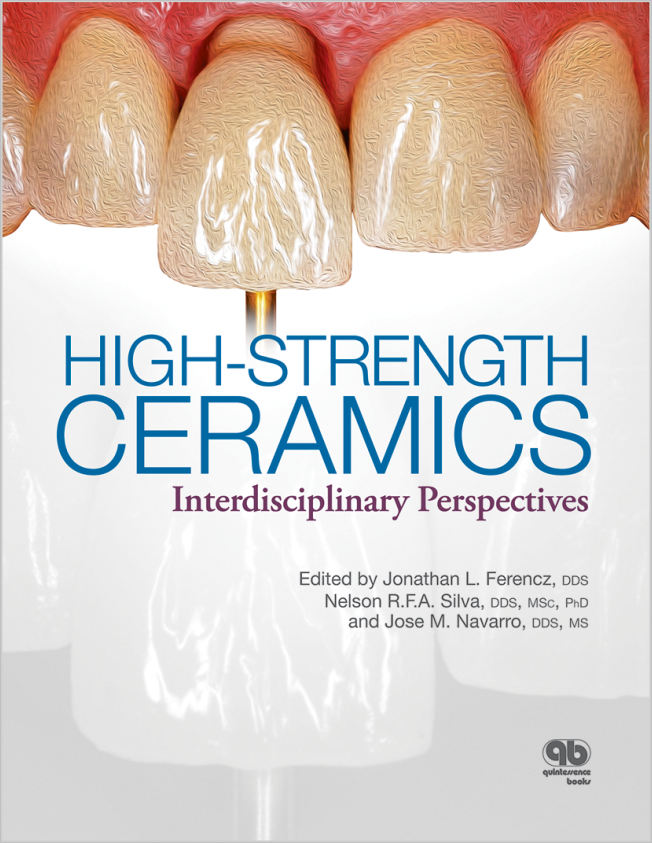The International Journal of Prosthodontics, 1/2021
Pages 118-119, Language: EnglishSilva, Nelson R. F. A. / Ferencz, Jonathan L. / Silva, Guilherme C.Intraoral scanners have been used to capture data for the design and subsequent manufacture of dental restorations and also for registering color clinical images. Scanners can capture datasets for future use and comparisons. This manuscript describes the potential of using software algorithms to superimpose 3D images captured at different times to calculate dimensional changes at the click of a button in various dental fields. 3D patient monitoring, with the advance of artificial intelligence and its built-in capacity for data analyses, will allow dentists and researchers to calculate volumetric changes and predict potentially adverse clinical outcomes.
QZ - Quintessenz Zahntechnik, 10/2019
ErfahrungsberichtPages 1224-1233, Language: GermanSilva, Nelson R. F. A. / Silveira, Rodrigo R. / Ferencz, Jonathan L. / Silva, Guilherme C.Ein digitales Konzept zur TherapiefindungIn dem Beitrag wird eine neue Monitoring-Software vorgestellt und erläutert. Mit dieser Software können Intraoralscans nach Zeitplänen erstellt und erfasst werden, die für das Patientenmonitoring bei verschiedenen klinischen Situationen geeignet sind.
Keywords: Intraoralscan, Software, Digitalisierung, Monitoring, Kommunikation
QZ - Quintessenz Zahntechnik, 8/2016
SciencePages 1020-1034, Language: GermanGracis, Stefano / Thompson, Van P. / Ferencz, Jonathan L. / Silva, Nelson R. F. A. / Bonfante, Estevam A.Der Beitrag schlägt ein Klassifikationssystem für keramische und keramikähnliche Restaurationsmaterialien unter Berücksichtigung einer neuen Materialklasse vor. Die neue Klassifikation ordnet keramische Restaurationsmaterialien in drei Familien: Glasmatrix-, polykristalline und Kunststoffmatrix-Keramiken. Außerdem werden die vom Hersteller angegebenen klinischen Indikationen der verschiedenen Materialien genannt, die Verarbeitungstechniken werden überblicksartig aufgeführt und es wird angegeben, ob die Materialien als Gerüstwerkstoffe oder für monolithische Lösungen verwendet werden.
Keywords: Dentalkeramik, Klassifikation, Glaskeramik, polykristalline Keramik, Kunststoffmatrixkeramik, Feldspatkeramik, Lithiumdisilikat, Zirkonoxid, Aluminiumoxid, Kunststoffnanokeramik, Hybridkeramik
The International Journal of Prosthodontics, 3/2015
DOI: 10.11607/ijp.4244, PubMed ID (PMID): 25965634Pages 227-235, Language: EnglishGracis, Stefano / Thompson, Van P. / Ferencz, Jonathan L. / Silva, Nelson R. F. A. / Bonfante, Estevam A.Classification systems for all-ceramic materials are useful for communication and educational purposes and warrant continuous revisions and updates to incorporate new materials. This article proposes a classification system for ceramic and ceramic-like restorative materials in an attempt to systematize and include a new class of materials. This new classification system categorizes ceramic restorative materials into three families: (1) glass-matrix ceramics, (2) polycrystalline ceramics, and (3) resin-matrix ceramics. Subfamilies are described in each group along with their composition, allowing for newly developed materials to be placed into the already existing main families. The criteria used to differentiate ceramic materials are based on the phase or phases present in their chemical composition. Thus, an all-ceramic material is classified according to whether a glass-matrix phase is present (glass-matrix ceramics) or absent (polycrystalline ceramics) or whether the material contains an organic matrix highly filled with ceramic particles (resin-matrix ceramics). Also presented are the manufacturers' clinical indications for the different materials and an overview of the different fabrication methods and whether they are used as framework materials or monolithic solutions. Current developments in ceramic materials not yet available to the dental market are discussed.
The International Journal of Prosthodontics, 1/2015
DOI: 10.11607/ijp.3879, PubMed ID (PMID): 25588178Pages 75-78, Language: EnglishMitsias, Miltiadis E. / Thompson, Van P. / Pines, Mitchel / Silva, Nelson R. F. A.Fracture strength and accelerated fatigue reliability of two zirconia abutment systems were tested. Thirty-six implants with a Morse taper (MT; n = 18) or cone (C; n = 18) design were restored with metallic crowns. Loads were applied as single load to failure (SLF) or mouth-motion cycles using a step-stress accelerated life testing (SALT) method. SLF mean values were 690 ± 430 N and 209 ± 25 for MT and C groups, respectively. In terms of the SALT results, 8 specimens survived (50,000 cycles) and 7 failed (maximum load 400 N) in the MT group; whereas for the C group all abutments failed before the maximum number of cycles. Failure mode was fracture of the Y-TZP abutments for both groups. Higher reliability for a mission of 50,000 cycles at 175 N for MT versus C designs was determined, and significant differences in fracture modes were observed.
International Journal of Computerized Dentistry, 3/2014
PubMed ID (PMID): 25558761Pages 219-238, Language: English, GermanHajtó, Jan / Marinescu, Costin / Silva, Nelson R. F. A.Background and purpose: Different digital software tools are available today for the purpose of designing anatomically correct anterior and posterior restorations. The current concepts present weaknesses, which can be potentially addressed by more advanced modeling tools, such as the ones already available in professional CAD (Computer Aided Design) graphical software.
Aim: This study describes the morphogenic designer (MGD) as an efficient and easy method for digitally designing tooth forms for the anterior and posterior dentition.
Materials and Method: Anterior and posterior tooth forms were selected from a collection of digitalized natural teeth and subjectively assessed as "average". The models in the form of STL files were filtered, cleaned, idealized, and re-meshed to match the specifications of the software used. The shapes were then imported as wavefront ".obj" model into Modo 701, software built for modeling, texturing, visualization, and animation.
Results: In order to create a parametric design system, intentional interactive deformations were performed on the average tooth shapes and then further defined as morph targets. By combining various such parameters, several tooth shapes were formed virtually and their images presented.
Conclusion: MGD proved to be a versatile and powerful tool for the purpose of esthetic and functional digital crown designs.
Keywords: computerized dentistry, dental 3D modeling, morphogenic tooth design, digital tooth design
The International Journal of Oral & Maxillofacial Implants, 1/2013
DOI: 10.11607/jomi.2443, PubMed ID (PMID): 23377054Pages 103-108, Language: EnglishAlmeida, Erika O. / Freitas jr., Amilcar C. / Bonfante, Estevam A. / Marotta, Leonard / Silva, Nelson R. F. A. / Coelho, Paulo G.Purpose: This study evaluated the reliability and failure modes of anterior implants with internal-hexagon (IH), external-hexagon (EH), or Morse taper (MT) implant-abutment interface designs. The postulated hypothesis was that the different implant-abutment connections would result in different reliability and failure modes when subjected to step-stress accelerated life testing (SSALT) in water.
Materials and Methods: Sixty-three dental implants (4 × 10 mm) were divided into three groups (n = 21 each) according to connection type: EH, IH, or MT. Commercially pure titanium abutments were screwed to the implants, and standardized maxillary central incisor metallic crowns were cemented and subjected to SSALT in water. The probability of failure versus number of cycles (95% two-sided confidence intervals) was calculated and plotted using a power-law relationship for damage accumulation. Reliability for a mission of 50,000 cycles at 150 N (90% two-sided confidence intervals) was calculated. Polarized-light and scanning electron microscopes were used for failure analyses.
Results: The beta values (confidence intervals) derived from use-level probability Weibull calculation were 3.34 (2.22 to 5.00), 1.72 (1.14 to 2.58), and 1.05 (0.60 to 1.83) for groups EH, IH, and MT, respectively, indicating that fatigue was an accelerating factor for all groups. Reliability was significantly different between groups: 99% for MT, 96% for IH, and 31% for EH. Failure modes differed; EH presented abutment screw fracture, IH showed abutment screw and implant fractures, and MT displayed abutment and abutment screw bending or fracture.
Conclusions: The postulated hypothesis that different implant-abutment connections to support anterior single-unit replacements would result in different reliability and failure modes when subjected to SSALT was accepted.
Keywords: cementation, dental implants, fractography, implant-supported prostheses, reliability, step-stress accelerated life testing
International Journal of Esthetic Dentistry (DE), 4/2012
Pages 372-394, Language: GermanVan Dooren, Eric / Calamita, Marcelo / Calgaro, Murilo / Coachmann, Christian / Ferencz, Jonathan L. / Pinho, Claudio / Silva, Nelson R. F. A.Ziel dieses Übersichtsberichts ist es, mehrere In-vitro- und In-vivo-Studien zum Ergebnis von einteiligen Zirkonoxidimplantaten zu diskutieren und zwei klinische Fälle vorzustellen, in denen Prototypen von Zirkonoxidimplantaten eingesetzt wurden. Ein Schwerpunkt hierbei liegt auf den möglichen wissenschaftlichen und klinischen Bedenken, die es im Hinblick auf die funktionellen, biologischen und ästhetischen Langzeitergebnisse gibt.
International Journal of Esthetic Dentistry (EN), 4/2012
PubMed ID (PMID): 23150869Pages 396-417, Language: EnglishVan Dooren, Eric / Calamita, Marcelo / Calgaro, Murilo / Coachman, Christian / Ferencz, Jonathan L. / Pinho, Claudio / Silva, Nelson R. F. A.The objective of this narrative overview is to discuss several in vitro and in vivo studies regarding the performance of one-piece zirconia implants in combination with the description of two clinical scenarios where zirconia implant prototypes were utilized with emphasis on the possible scientific and clinical concerns that may affect the functional, biological and esthetic long-term outcomes.
The International Journal of Prosthodontics, 6/2011
PubMed ID (PMID): 22146255Pages 557-561, Language: EnglishFreitas-Júnior, Amilcar C. / Bonfante, Estevam A. / Martins, Leandro M. / Silva, Nelson R. F. A. / Marotta, Leonard / Coelho, Paulo G.The reliability and failure modes of molar crowns supported by three different implant-supported designs were tested according to the following groups: group 1, one standard-diameter implant (3.75 mm); group 2, one narrow-diameter implant (3 mm); and group 3, two narrow-diameter implants (3 mm). Loads were applied as mouth-motion cycles using a step-stress accelerated life-testing method. ß values for groups 1 and 3 (1.57 and 2.48, respectively) indicated that fatigue accelerated the failure of both groups, but not for group 2 (0.39). Abutment screw failure was the chief failure mode. Strength and reliability were significantly higher for groups 1 and 3 compared to group 2.








